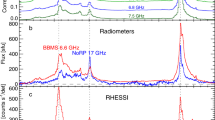Abstract
‘Flaring arches” is a name assigned to a particular component of some flares. This component consists of X-ray and Hα emission which traverses a coronal arch from one to the other of its chromospheric footpoints. The primary footpoint is at the site of a flare. The secondary footpoint, tens of thousands of kilometers distant from the source flare, but in the same active region, brightens in Hα concurrent with the beginning of the hard X-ray burst at the primary site. From the inferred travel time of the initial exciting agent we deduce that high speed electron streams travelling through the arch must be the source of the initial excitation at the secondary footpoint. Subsequently, a more slowly moving agent gradually enhances the arch first in X-rays and subsequently in Hα, starting at the primary footpoint and propagating along the arch trajectory. The plasma flow in Hα shows clearly that material is injected into the arch from the site of the primary footpoint and later on, at least in some events, a part of it is also falling back.
Thus a typical flaring arch has three, and perhaps four consecutive phases: (1) An early phase characterized by the onset of hard X-ray burst and brightening of the secondary footpoint in Hα. (2) The main X-ray phase, during which X-ray emission propagates through the arch. (3) The main Hα phase, during which Hα emitting material propagates through the arch. And (4) an aftermath phase when some parts of the ejected material seem to flow in the reverse direction towards the primary site of injection.
An extensive series of flaring arches was observed from 6 to 13 November, 1980 at the Big Bear Solar Observatory and with the Hard X-Ray Imaging Spectrometer (HXIS) on board the SMM in a magnetically complex active region. The two most intense arches for which complete Hα and X-ray data are available and which occurred on 6 November at 17 ∶ 21 UT (length ≈ 57000 km) and on 12 November at 16 ∶ 57 UT (length ≈ 263 000 km) are discussed in this paper.
Similar content being viewed by others
References
Brown, J. C.: 1971, Solar Phys. 18, 489.
Bruzek, A.: 1967, Solar Phys. 2, 451.
Dennis, B. R., Orwig, L. E., Kiplinger, A. L., Gibson, B. R., Kennard, G. S., and Tolbert, A. K.: 1985, The Hard X-Ray Bursts Spectrometer Event Listing 1980–1985, NASA TM 86236.
Duijveman, A., Hoyng, P., and Machado, M. E.: 1982, Solar Phys. 81, 137.
Heinzel, P. and Karlický, M.: 1987, Solar Phys. 110, 343.
Hoyng, P., Brown, J. C., and van Beek, H. F.: 1976, Solar Phys. 48, 197.
MacNeice, P., Pallavicini, R., Mason, H. E., Simnett, G. M., Antonucci, E., Shine, R. A., Rust, D. M., Jordan, C., and Dennis, B. R.: 1985, Solar Phys. 99, 167.
Martin, S. F.: 1979, Proc. US-Indo Workshop on Solar Terrestrial Physics, 12–16 June 1979, Udaipur, India, p. 25.
Martin, S. F. and Švestka, Z.: 1987, Bull. Am. Astron. Soc. 18, 898.
Mewe, R., Gronenschild, E. H. B. M., and van de Oord, G. H. J.: 1985, Astron. Astrophys. Suppl. 62, 197.
Mouradian, Z., Martres, M. J., and Soru-Escaut, I.: 1983, Solar Phys. 87, 309.
Orwig, L. E., Frost, K. J., and Dennis, B. R.: 1980, Solar Phys. 65, 25.
Rust, D. M. and Webb, D. F.: 1977, Solar Phys. 54, 403.
Rust, D. M., Simnett, G. M., and Smith, D. F.: 1985, Astrophys. J. 288, 401.
Solar Geophysical Data: 1981a, No. 437, Part I, p. 126.
Solar Geophysical Data: 1981b, No. 441, Part II, p. 26.
Solar Geophysical Data: 1983, No. 467, Part 2, pp. 34 and 49.
Švestka, Z.: 1984, Solar Phys. 94, 171.
Švestka, Z.: 1987, Solar Phys. (Letter) 108, 411.
Švestka, Z., Schrijver, J., Somov, B., Dennis, B. R., Woodgate, B. E., Fuerst, F., Hirth, W., Klein, L., and Raoult, A.: 1983, Solar Phys. 85, 313.
Švestka, Z., Fontenla, J. M., Machado, M. E., Martin, S. F., Neidig, D. F., and Poletto, G.: 1987, Solar Phys. 108, 237.
Švestka, Z., Fárník, F., Fontenla, J. M., and Martin, S. F.: 1988, Solar Phys. (in preparation, Paper II).
Tang, F.: 1982, Solar Phys. 77, 263.
Van Beek, H. F., Hoyng, P., Lafleur, B., and Simnett, G. M.: 1980, Solar Phys. 65, 39.
Zirin, H.: 1987, Astrophysics of the Sun, Cambridge Univ. Press, Cambridge.
Author information
Authors and Affiliations
Rights and permissions
About this article
Cite this article
Martin, S.F., Švestka, Z.F. Flaring arches. Sol Phys 116, 91–118 (1988). https://doi.org/10.1007/BF00171717
Revised:
Issue Date:
DOI: https://doi.org/10.1007/BF00171717




